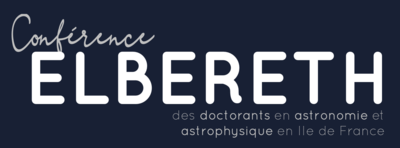Orateur
Description
Methanol was detected on Centaur Pholus and on Trans-Neptunian Objects (TNOs) 2002 VE95 and Arrokoth through direct observations of its NIR bands [1,2]. Methanol is commonly found alongside water ice, which is the most abundant species detected on the surface of TNOs [3]. TNOs are believed to have preserved the physico-chemical properties of the first stages of formation of the outer Solar System, but their surfaces are subjected to irradiation by cosmic or solar ions that modify their original chemical composition.
Laboratory studies of energetic processing of methanol by ion-irradiation showed the formation of species such as $CO_{2}$ and $CO$ whose abundance depends on the irradiation dose [4,5]. Energetic and thermal processing ultimately produce complex organic molecules in the form of a refractory residue and induce changes in spectral colors, in particular a reddening of the Vis-NIR spectra of the original samples [6].
We present an experimental setup used to monitor the chemistry induced by irradiation and to provide data relevant to TNOs’ observations. The INGMAR experimental setup consists of a high vacuum chamber interfaced to the SIDONIE ion implanter (IJCLab). This allows for irradiation of ice mixtures cooled by a closed-cycle He-cryocooler (12-300 K). Spectroscopic data are acquired in transmittance or reflectance configurations and cover the 0.4-25 µm spectral range.
While chemical complexity, native or driven by energetic processing [7], can be investigated by MIR spectroscopy, Vis-NIR data are necessary to interpret TNOs’ and Centaurs’ observations. Previous experiments investigated NIR methanol bands as probes of energetic processing [8]. Here we report experiments on $H_2O:CH_3OH$ (1:1) mixtures deposited at 35 or 60 K and exposed to 30 keV $H^+$ up to doses relevant to TNOs’ lifetime in the outer Solar System. We focused on Vis-NIR spectra as we aim at expanding the spectroscopic data available to link chemical composition to the diversity of TNOs’ Vis-NIR slopes. We will discuss the implications of our experimental results for the interpretation of current New Horizons and future JWST observations.
References
[1] Merlin, F. et al. 2012, A&A, 544, A20.
[2] Grundy et al. 2020, Science, 367, 6481.
[3] Barucci et Merlin 2020, The Trans-Neptunian Solar System, p. 109-126.
[4] Baratta, G. A. et al. 1994, Planet. Space Sci., 42, 9.
[5] Moore, M. H. et al. 1996, Planet. Space Sci., 44, 9.
[6] Brunetto, R. et al. 2006, ApJ, 644, 646.
[7] Dalle Ore, C. M. et al. 2011, A&A, 533, A98.
[8] Urso, R. G. et al. 2020, ApJ, 894, L3.
Day constaints
Available for presentation :
- wednesday 23 afternoon (preferably after 2 pm)
- thursday 24 all day
- friday 25 afternoon (preferably after 2 pm)
| Field | Planetology (including small bodies and exoplanets) |
|---|

